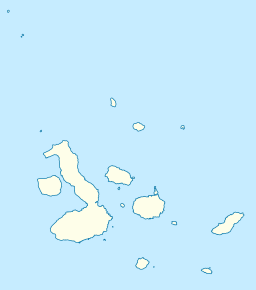Cerro Pajas facts for kids
Quick facts for kids Cerro Pajas |
|
|---|---|
 |
|
| Highest point | |
| Elevation | 640 m (2,100 ft) |
| Prominence | 359 m (1,178 ft) |
| Listing | Ultra |
| Geography | |
| Location | Floreana Island, Galápagos Islands, Ecuador |
Cerro Pajas is a volcano found on Floreana Island in the amazing Galápagos Islands, Ecuador. It's not active anymore, meaning it won't erupt. At 640 meters (about 2,100 feet) tall, it's the highest point on Floreana Island!
Amazing Wildlife at Cerro Pajas
Around the top of Cerro Pajas, you'll find a big forest of special trees called Scalesia pedunculata. This forest is super important! It's home to many kinds of Darwin's finches, including the medium tree finch. This finch is in big trouble, as there are very few left.
Saving the Petrels
Cerro Pajas is also home to the most important group of Galapagos petrels on Floreana Island. These special birds nest here.
Back in 1981, scientists worried about the petrels. Their numbers were dropping fast, by about 33% each year! This was because of animals that people brought to the island, like black rats, cats, pigs, goats, and donkeys. These animals would eat the petrel eggs and chicks. Also, a plant called Lantana camara, brought to the island in 1938, was taking over the petrels' nesting areas.
To help the petrels, the World Wildlife Fund started a five-year plan in 1982. They worked to control the rats, cats, pigs, goats, and donkeys.
Before 1984, the people living on Floreana Island called Cerro Pajas a "Protected Area". This idea came from a local conservationist named Felipe Cruz. In the early 1980s, the first program to control rats at Cerro Pajas began. The goal was to help the petrels have more babies. Malcolm Coulter, a bird expert from the Charles Darwin Research Station, started this program. Felipe Cruz and Tina Beach continued his work.
In 1983, the first year they controlled the rats, the petrels' nesting success went up from 31% to 46%. This was great news, even though heavy rain caused some nests to collapse. The next year, things got even better! Out of 100 nests, 72 chicks grew up and flew away. Hunting cats, goats, donkeys, and pigs also helped keep the petrel nests safe. Throughout the 1980s, continuing to control rats helped the petrels keep having many successful nests.
Gallery
-
Galapagos petrel nesting under a boulder at Cerro Pajas.
See also
 In Spanish: Cerro Pajas para niños
In Spanish: Cerro Pajas para niños
- Asilo de la Paz





